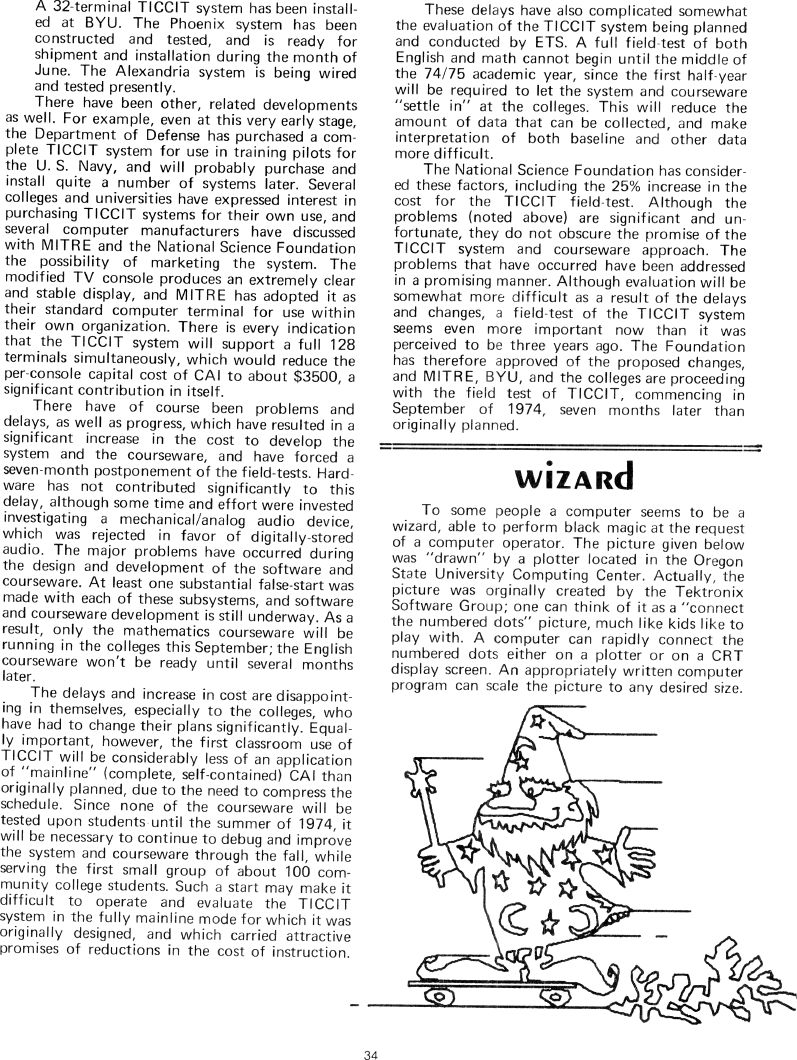The Best of Creative Computing Volume 1 (published 1976)
TICCIT System Progress Report on Field Testing

A 32-terminal TICCIT system has been installed
at BYU. The Phoenix system has been
constructed and tested, and is ready for
shipment and installation during the month of
June. The Alexandria system is being wired
and tested presently.
There have been other, related developments
as well. For example, even at this very early stage,
the Department of Defense has purchased a complete
TlCClT system for use in training pilots for
the U. S. Navy, and will probably purchase and
install quite a number of systems later. Several
colleges and universities have expressed interest in
purchasing TICCIT systems for their own use, and
several computer manufacturers have discussed
with MITRE and the National Science Foundation
the possibility of marketing the system. The
modified TV console produces an extremely clear
and stable display, and MITRE has adopted it as
their standard computer terminal for use within
their own organization. There is every indication
that the TICCIT system will support a full 128
terminals simultaneously, which would reduce the
per-console capital cost of CAI to about $3500, a
significant contribution in itself.
There have of course been problems and
delays, as well as progress, which have resulted in a
significant increase in the cost to develop the
system and the courseware, and have forced a
seven-month postponement of the field-tests. Hardware
has not contributed significantly to this
delay, although some time and effort were invested
investigating a mechanical/analog audio device,
which was rejected in favor of digitally-stored
audio. The major problems have occurred during
the design and development of the software and
courseware. At least one substantial false-start was
made with each of these subsystems, and software
and courseware development is still underway. As a
result, only the mathematics courseware will be
running in the colleges this September; the English
courseware won't be ready until several months
later.
The delays and increase in cost are disappointing
in themselves, especially to the colleges, who
have had to change their plans significantly. Equally
important, however, the first classroom use of
TICCIT will be considerably less of an application
of "mainline" (complete, self-contained) CAI than
originally planned, due to the need to compress the
schedule. Since none of the courseware will be
tested upon students until the summer of 1974, it
will be necessary to continue to debug and improve
the system and courseware through the fall, while
serving the first small group of about 100 community
college students. Such a start may make it
difficult to operate and evaluate the TlCClT
system in the fully mainline mode for which it was
originally designed, and which carried attractive
promises of reductions in the cost of instruction.
These delays have also complicated somewhat
the evaluation of the TICCIT system being planned
and conducted by ETS. A full field-test of both
English and math cannot begin until the middle of
the 74/75 academic year, since the first half-year
will be required to let the system and courseware
"settle in" at the colleges. This will reduce the
amount of data that can be collected, and make
interpretation of both baseline and other data
more difficult.
The National Science Foundation has considered
these factors, including the 25% increase in the
cost for the TICCIT field-test. Although the
problems (noted above) are significant and unfortunate,
they do not obscure the promise of the
TICCIT system and courseware approach. The
problems that have occurred have been addressed
in a promising manner. Although evaluation will be
somewhat more difficult as a result of the delays
and changes, a field-test of the TICCIT system
seems even more important now than it was
perceived to be three years ago. The Foundation
has therefore approved of the proposed changes,
and MITRE, BYU, and the colleges are proceeding
with the field test of TICCIT, commencing in
September of 1974, seven months later than
originally planned.
***
Wizard
To some people a computer seems to be a
wizard, able to perform black magic at the request
of a computer operator. The picture given below
was ”drawn" by a plotter located in the Oregon
State University Computing Center. Actually, the
picture was orginally created by the Tektronix
Software Group; one can think of it as a ”connect
the numbered dots" picture, much like kids like to
play with. A computer can rapidly connect the
numbered dots either on a plotter or on a CRT
display screen. An appropriately written computer
program can scale the picture to any desired size.
[Image]
34


